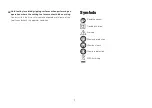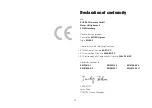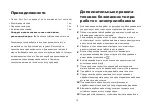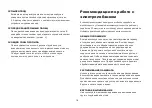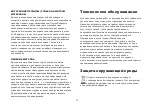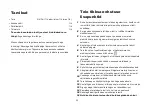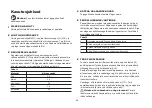
10
Working hints for your jigsaw
If your power tool becomes too hot, especially when used at low
speed, set the speed to maximum and run no Load for 2-3 minutes to
cool the motor. Avoid prolonged usage at very low speeds.
GENERAL
Always use a blade suited to the material and material thickness to
be cut. Always ensure the work–piece is firmly held or clamped to
prevent movement. For easier control, use low speed to start cutting,
then increase to correct speed.
Any movement of the material may affect the quality of the cut. The
blade cuts on the upward stroke and may chip the uppermost. Ensure
your uppermost surface is a non-visible surface when your work is
finished.
CUTTING LAMINATES
Use a fine tooth blade when cutting most laminates and thin wood
materials. To reduce edge chipping, clamp pieces of waste wood at
both ends on both sides and cut through the wood during cutting.
CIRCLE CUTTING
Do not use the pendulum action when cutting tight circles or angles.
POCKET CUTTING (SOFT MATERIALS ONLY)
To cut material out, either drill a hole large enough to insert the jig saw
blade or proceed as follows. Clearly mark the area to be cut. Position
the jigsaw over the marked area with the rounded front edge of the
base plate resting on the surface (See K). Ensure the blade is not
touching but is close to the work surface. Switch the jigsaw on and
gently swing the blade down into the material but maintain a pivoting
force on the front edge of the base. Only when the blade has fully
penetrated the material and the full length of the base plate is firmly
resting on the work surface, you move the jigsaw forward for normal
cutting.
METAL CUTTING
Use a finer tooth blade for ferrous metals and a coarse tooth blade
for non-ferrous metals. When cutting thin sheet metals always clamp
wood on both sides of the sheet to reduce vibration or tearing of the
sheet metal. Both wood and sheet metal must be cut. Do not force
the cutting blade when cutting thin metal or sheet steel, as they are
harder materials and will take longer to cut. Excessive blade force
may reduce the life of the blade or damage the motor. To reduce heat
during metal cutting, add a little lubricant along the cutting line.
Maintenance
Remove the plug from the socket before carrying out any
adjustment, servicing or maintenance.
Your power tool requires no additional lubrication or maintenance.
There are no user serviceable parts in your power tool. Never use
water or chemical cleaners to clean your power tool. Wipe clean with
a dry cloth. Always store your power tool in a dry place. Keep the
motor ventilation slots clean. Keep all working controls free of dust.
Occasionally you may see sparks through the ventilation slots. This is
normal and will not damage your power tool.
If the supply cord is damaged, it must be replaced by the
manufacturer, its service agent or similarly qualified persons in order
to avoid a hazard.







